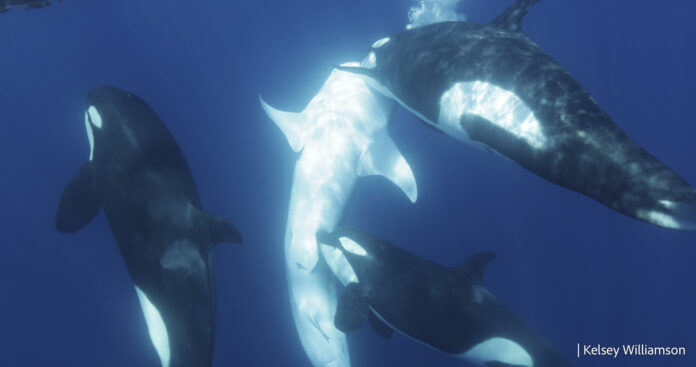Orcas can get organized. When hunting for whale sharks — the world’s largest fish — a pod of killer whales appears to target the youngest most vulnerable sharks, ram them to turn them upside done — thus immobilizing them, and will then focus on high value organs like the heart and liver.
Although there have been scattered reports of such incidents, scientists in Mexico recorded and studied four specific attacks, analyzed them, and described them in an article in Frontiers in Marine Science. Orcas have also been recorded hunting great white sharks solo. The article documents what appears to be systematic, coordinated attacks.
“We show how orcas displayed a collaboratively hunting technique on whale sharks, characterized by focusing on attacking the pelvic area causing the whale shark to bleed out and allow orcas access to the lipid-rich liver,” Erick Higuera Rivas, a marine biologist at Conexiones Terramar and an author of the article said in a press release. “When hunting, all pod members work together, hitting the whale shark to turn it upside down.”
Read More: Instead of Hunting in Groups, Orcas May be Attacking Great White Sharks Alone
Capturing the Killer Whale Hunt
Killer whales surface to breath before taking whale shark down and delivering a rapid, final blow. (Credit: Kelsey Williamson)
Turning the prey upside down essentially immobilizes it, preventing it from swimming away or diving deeper. The tactic also exposes the prey’s most vulnerable area. A whale shark’s undercarriage — or ventral side — has less protection from bone or cartilage than its dorsal side. It also provides easier access to nutrient-rich organs like the heart and liver. However, the scientists were unable to record the orcas eating specific organs.
Members of the public and the scientists captured four such hunts on video between 2018 and 2024 in the southern Gulf of California. The scientists identified individual pod members through distinctive dorsal fins, scars, and other markings.
One male, named Moctezuma, participated in three of the four recorded hunts. A female — seen with him in other circumstances — also joined in one hunt.
It’s possible one specific pod developed, then honed, these group-hunting tactics. Other pods might use similar strategies, but so far there is little evidence that this is a common behavior.
Read More: Killer Whale Group Employs Deep-Sea Hunting Techniques
Orca Sighting Implications
Several of the killer whales were observed with whale shark carrion in their mouths during an attack on 26 May 2024. (Credit: Kelsey Williamson)
Even though sightings of such hunts are relatively rare, the fact that they can occur has some implications.
First, the gulf of California should be monitored so that tourists or fishermen don’t interfere with the aquatic mammals. Also, the pod should be closely observed to see how climate change affects them. For example, prey might disappear due to warming water.
Researchers also need to understand why this pod in particular chose whale sharks as food, and also determine if all orcas employ a similar group hunting technique. But for now, we can appreciate their ingenuity.
“It is very impressive how orcas work together strategically and intelligently to access only a very specific area of the prey,” Higuera Rivas said in a statement. “It highlights what great predators they are.”
Article Sources
Our writers at Discovermagazine.com use peer-reviewed studies and high-quality sources for our articles, and our editors review for scientific accuracy and editorial standards. Review the sources used below for this article:
Before joining Discover Magazine, Paul Smaglik spent over 20 years as a science journalist, specializing in U.S. life science policy and global scientific career issues. He began his career in newspapers, but switched to scientific magazines. His work has appeared in publications including Science News, Science, Nature, and Scientific American.
Source : Discovermagazine






